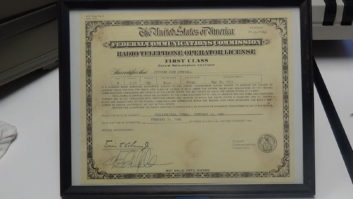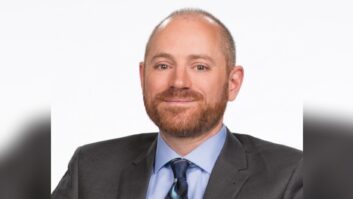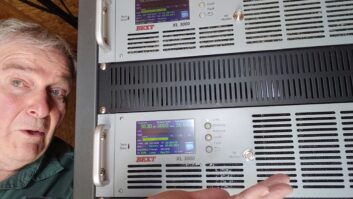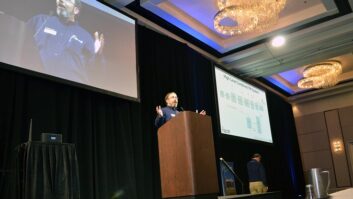His given name was Jeffrey M. Bixby, but across the engineering community in Pennsylvania, Washington and beyond, the engineer who died this year at age 61 was known simply as “Bix.”
(click thumbnail)Bixby was fond of this photo, taken as he did the KDKA station ID. He kept the picture hanging in his office in recent years.Photo courtesy of Mike Rhodes
A 1970 graduate of Juniata College in Pennsylvania, Bixby began his engineering career at WJUN(AM) in Mexico, Pa. Early work included consulting jobs with John H. Mullaney and Associates, Collins/Rockwell and A.D. Ring and Associates, where he developed a reputation as a hard-working, no-nonsense expert on AM directional antenna systems.
“He was a curmudgeon,” recalled Anne Gallagher, now an engineer with the FCC. Her husband worked with Bixby at Moffet, Larson and Johnson, where Bixby was an engineering manager from 1985 until 1998.
Gallagher joined the firm in 1995, and she says Bixby served as her mentor there.
“You could hear him come in in the morning. He had a brisk stride and he always wore cowboy boots, so you could hear him before you’d see him.”
Complex tasks
During his tenure at MLJ, Bixby worked on several projects that would become highlights of his career. In Pittsburgh, he handled the replacement of KDKA(AM)’s aging Franklin antenna with a new tower, specifically designed to minimize skywave.
When the new antenna was in place and KDKA was ready to sign on with it, Bixby did something that had become a signature for him.
“When a project was done, he would always insist that he be behind the mike giving the first legal ID when it signed on,” said Tim Portzline, chief engineer for Clear Channel in Harrisburg, Pa.
A few years later, Bixby embarked on what would prove to be one of his biggest challenges: replacing the four-tower array at Group W’s WINS(AM) in New York with a new antenna system at the same site, navigating the complicated local politics and keeping the station on the air throughout the construction.
“When I got to WINS in 1995, (Bix) was the primary partner in MLJ and Westinghouse was their biggest client,” said Mark Olkowski, now engineering manager for WINS, WFAN(AM) and WCBS(AM). “They had worked for Westinghouse for many years to get the WINS array licensed.”
Instead of continuing to struggle to get the old in-line array to tune up, Bixby designed a four-tower parallelogram array for the station.
“One of the biggest challenges was keeping the station on the air,” Gallagher said. “One of the new towers was going up right on top of an old tower. Rather than go nondirectional with 25 percent power, Bix cobbled together a three-tower directional array and phasor out of the parts that were on-site.”
Such a move normally would require an expensive and time-consuming proof, but Gallagher says Bixby was able to persuade the FCC to approve it without a proof, arguing that the constantly moving construction cranes on the site would make a proof impossible.
Detuning
Olkowski recalls Bixby as “very much a man’s man … with a very low tolerance for B.S., at the corporate level or otherwise.” He credits Bixby for a substantial increase in WINS’ signal when the new antenna system went into use.
Other Bixby projects during the era included major directional system rebuilds at WBT(AM) Charlotte, WIND(AM) Chicago and WGBS(AM) Miami.
After leaving MLJ in 1998, Bixby worked with Tracy Corp. and Denny & Associates. In 2002, Bixby and his wife, P.J. McDaniels, moved from Washington to rural central Pennsylvania, where Bixby went into business for himself as BixTech LLC, working with Verizon Wireless and Sprint to detune their facilities near AM broadcasters.
“I think my husband pretty much developed that model of detuning,” McDaniels said.
McDaniels met Bixby through a personal ad in 1982, and the couple had just celebrated their 21st anniversary in June with a renewal of their vows.
“He was just always surrounded by people,” she said. “He always had great stories to tell.”
In addition to his engineering work, Bixby was active in amateur radio under the call W4BIX. A Navy veteran, Bixby, with McDaniels, was active in Army MARS and as a Coast Guard Auxiliary radio operator.
BixTech “was becoming a nice little business,” McDaniels said, when Bixby was diagnosed with cancer late in 2004.
As the disease took its toll, Bixby’s engineering colleagues in the region moved to present him with a final honor. The Pennsylvania Association of Broadcasters created a “Broadcast Tube Plaque” for Bixby; in early June several SBE members made the drive north from Harrisburg for a small ceremony at Bixby’s home.
Portzline says Bixby was confined to bed by then, but alert and appreciative. “He was very weak, but he was talking, reminiscing about projects he had worked on,” Portzline said.
“The professional recognition at the very end kind of wrapped it up for him,” McDaniels said. “He felt like he had accomplished everything.”
Portzline says what he’ll remember best about Bixby is his modesty.
“He just came across as being very unassuming, a very down-to-earth guy. He could have made a big deal about the jobs he had done, but he was always very matter-of-fact,” he said.













